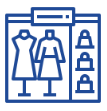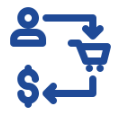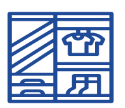This course leads students into the exciting and ever-changing world of fashion. Students gain knowledge of marketing as it relates to the fashion industry. From brick-and-mortar retail establishments to online retail and social media marketing, students will explore aspects such as trends, technology, the buying process, visual merchandising, the nature and history of fashion and fashion designers, and the global impact of the fashion industry on the economy. Academic skills related to the content are part of this course. Students are eligible to sit for the National Retail Federation Customer Service and Sales Professional exam or the Business of Retail Operations: Operations and Profit exam for student-selected verified credit.
Virginia Beach City Public Schools ensures equal access to all CTE courses. Accessibility accommodations will be provided as needed.
|
Unit |
Professional Development  |
Foundations of Fashion  |
Fashion Mrk Mix & Concepts  |
Fashion Development  |
Selling & Customer Service  |
Fashion Retailing & Merchandising Dynamic  |
|
Focus |
We begin this course with learning how to write and format a resume and cover letter and how to correctly fill out a job application. Professional dress and interviewing skills are also practiced. |
Next, we define what fashion is and investigate trends that influence fashion. |
We transition into learning about what the marketing mix is and how brands are identified by their logos in the marketplace. |
Now we focus on how fashion has impacted history, how innovation and invention has changed fashion, and we identify the influential designers of the 20th century. |
Next, we move onto the importance of customer service, the steps to the selling process, and the characteristics of effective salespeople. |
We end the course by discussing how fashion has impacted the economy, how the rules of businesses have affected fashion, and the role of visual merchandising. |
|
Transfer Goal(s) |
|
|
|
|
|
|
|
Unit Learning Targets |
|
|
• Investigate the parts of the marketing mix for specific products and/orservices • Identify the brands through their logos/trademarks/trade characters • Create a marketing mix for a specific product and target market |
|
|
|
